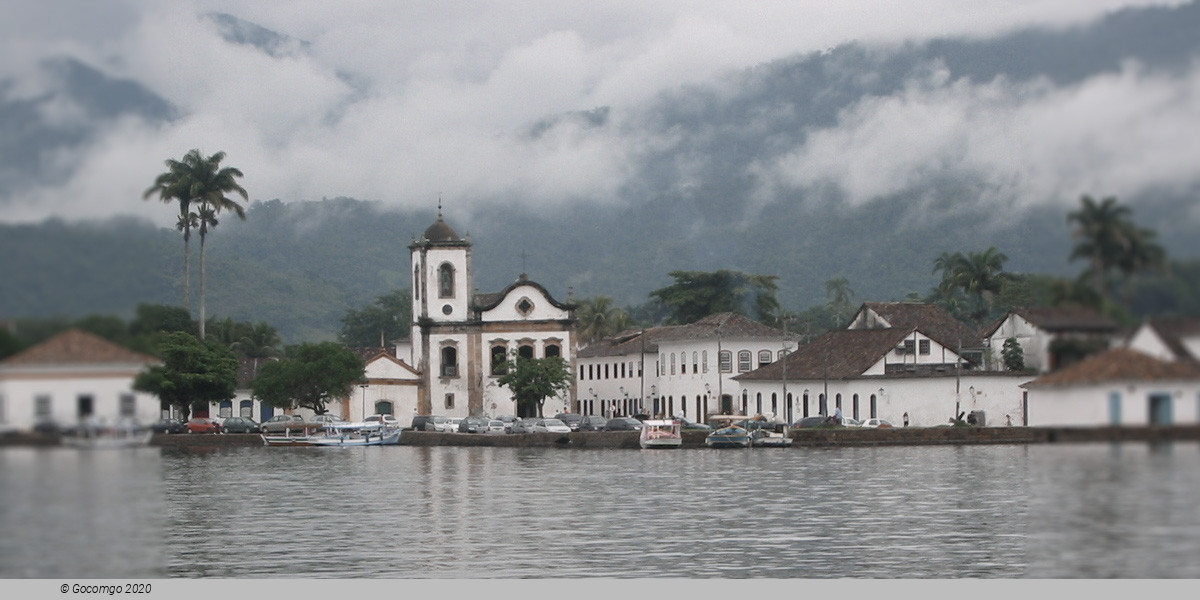Paraty

Paraty is a preserved Portuguese colonial (1500–1822) and Brazilian Imperial (1822–1889) municipality with a population of about 43,000. It is located on the Costa Verde (Green Coast), a lush green corridor that runs along the coastline of the state of Rio de Janeiro, in Brazil. Paraty has become a tourist destination, known for its historic town center and the coast and mountains in the region. The historic center of the city, as well as four areas of the Atlantic Forest, were inscribed on UNESCO World Heritage List in 2019 under the title "Paraty and Ilha Grande".
History
The village of Paraty was founded in 1597. It was established formally as a town by Portuguese colonists in 1667, in a region populated by the Guaianás Indians.
The Guaianás people who lived where the city now stands called the entire area “Paraty”. In the Tupi language “Paraty” means “river of fish”. Even today the Brazilian Mullet (Mugil brasiliensis) still come back to spawn in the rivers that spill into the Bay of Paraty. When the region was colonized by the Portuguese, they adopted the Guaianás name for their new town.
The Gold Trail
After the discovery of the world's richest gold mines in 1696 in the mountains of Minas Gerais, Paraty became an export port for gold to Rio de Janeiro and from there on to Portugal. The ensuing gold rush led to the construction of the "Caminho do Ouro" or "Gold Trail", a 1200 kilometer road, paved in steep areas with large stones, which connected Paraty to Diamantina via Ouro Preto and Tiradentes. Not only was it used to transport gold to Paraty, but it was also used to convey supplies, miners and African slaves by mule train over the mountains to and from the gold mining areas. Two sections of the Caminho do Ouro have been excavated near Paraty and are now a tourist destination for hiking.
The Gold Trail fell into disuse because of attacks on the gold-laden ships bound for Rio de Janeiro by pirates who frequented the islands and coves of the Bay of Angra dos Reis. Eventually, a safer overland route from Minas Gerais to Rio de Janeiro was created because of these pirate raids. Finally, the gold itself began to run out in the late 18th century, and Paraty declined.
The Gold Trail was submitted for inclusion on the World Heritage List in August 2004.
Economic revival
The city's economic activity revived as a port for a new boom, the coffee trade of the Paraiba do Sul River Valley in the early 19th century until a railway along the valley created cheaper transport to the port of Rio de Janeiro. Another smaller revival came late in the 19th century with the production of cachaça, which is a sugarcane-derived spirit best known today as the basis for Brazil's most famous cocktail, the caipirinha. The name "Paraty" in that period became synonymous with cachaça. Since then, Paraty has been out of the mainstream, which is why it did not change for centuries, until a paved road was built from Rio de Janeiro to Santos, near São Paulo, in the 1970s. The city then began a new cycle of activity, which transformed a small, almost abandoned town living on very limited economic activity, mainly fishing and agriculture (bananas, manioc, sugarcane) into a tourism destination.
Architecture
Paraty is known for the cobblestone-paved streets throughout the Historic Center District. No cars or trucks are allowed in this part of town, only foot traffic or bicycles. Motor vehicles are only allowed in the Historic District on Wednesdays for deliveries. Horses and carts are a very common sight in Paraty and are frequently used all around the city.
Paraty has been able to maintain many of its historic buildings. Much of the architecture of the city has not changed for 250 years or more.

